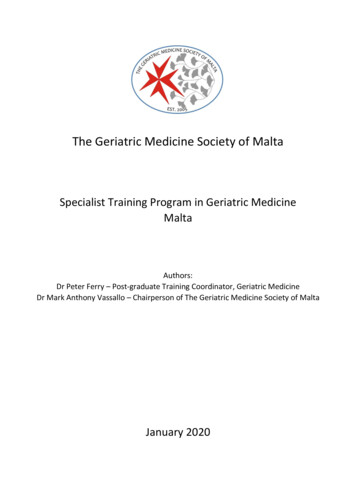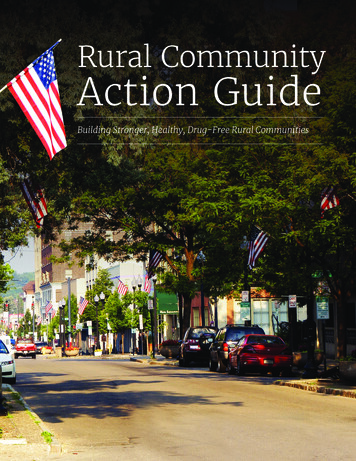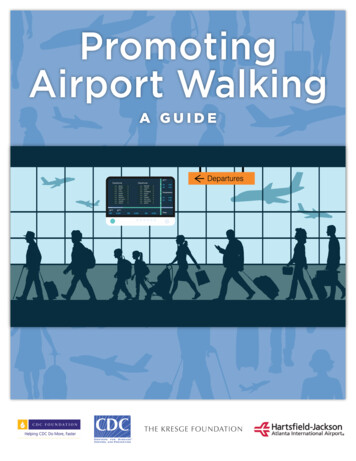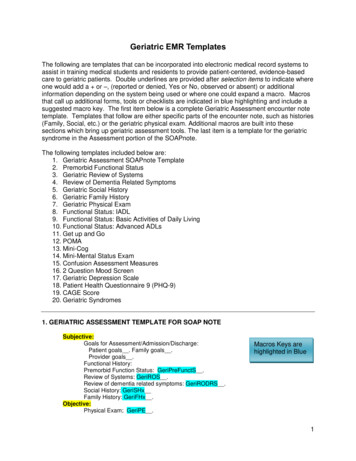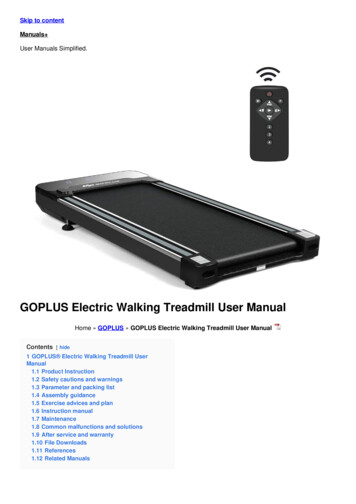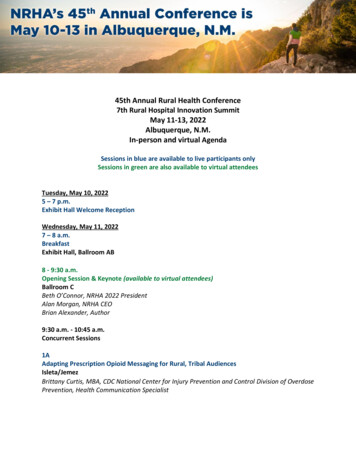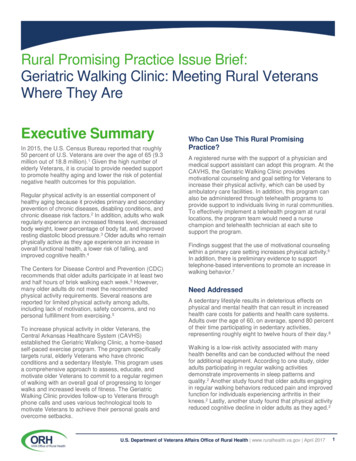
Transcription
Rural Promising Practice Issue Brief:Geriatric Walking Clinic: Meeting Rural VeteransWhere They AreExecutive SummaryIn 2015, the U.S. Census Bureau reported that roughly50 percent of U.S. Veterans are over the age of 65 (9.3million out of 18.8 million).1 Given the high number ofelderly Veterans, it is crucial to provide needed supportto promote healthy aging and lower the risk of potentialnegative health outcomes for this population.Regular physical activity is an essential component ofhealthy aging because it provides primary and secondaryprevention of chronic diseases, disabling conditions, andchronic disease risk factors.2 In addition, adults who walkregularly experience an increased fitness level, decreasedbody weight, lower percentage of body fat, and improvedresting diastolic blood pressure.3 Older adults who remainphysically active as they age experience an increase inoverall functional health, a lower risk of falling, andimproved cognitive health.4The Centers for Disease Control and Prevention (CDC)recommends that older adults participate in at least twoand half hours of brisk walking each week.5 However,many older adults do not meet the recommendedphysical activity requirements. Several reasons arereported for limited physical activity among adults,including lack of motivation, safety concerns, and nopersonal fulfillment from exercising.5To increase physical activity in older Veterans, theCentral Arkansas Healthcare System (CAVHS)established the Geriatric Walking Clinic, a home-basedself-paced exercise program. The program specificallytargets rural, elderly Veterans who have chronicconditions and a sedentary lifestyle. This program usesa comprehensive approach to assess, educate, andmotivate older Veterans to commit to a regular regimenof walking with an overall goal of progressing to longerwalks and increased levels of fitness. The GeriatricWalking Clinic provides follow-up to Veterans throughphone calls and uses various technological tools tomotivate Veterans to achieve their personal goals andovercome setbacks.Who Can Use This Rural PromisingPractice?A registered nurse with the support of a physician andmedical support assistant can adopt this program. At theCAVHS, the Geriatric Walking Clinic providesmotivational counseling and goal setting for Veterans toincrease their physical activity, which can be used byambulatory care facilities. In addition, this program canalso be administered through telehealth programs toprovide support to individuals living in rural communities.To effectively implement a telehealth program at rurallocations, the program team would need a nursechampion and telehealth technician at each site tosupport the program.Findings suggest that the use of motivational counselingwithin a primary care setting increases physical activity.6In addition, there is preliminary evidence to supporttelephone-based interventions to promote an increase inwalking behavior.7Need AddressedA sedentary lifestyle results in deleterious effects onphysical and mental health that can result in increasedhealth care costs for patients and health care systems.Adults over the age of 60, on average, spend 80 percentof their time participating in sedentary activities,representing roughly eight to twelve hours of their day. 8Walking is a low-risk activity associated with manyhealth benefits and can be conducted without the needfor additional equipment. According to one study, olderadults participating in regular walking activitiesdemonstrate improvements in sleep patterns andquality.2 Another study found that older adults engagingin regular walking behaviors reduced pain and improvedfunction for individuals experiencing arthritis in theirknees.2 Lastly, another study found that physical activityreduced cognitive decline in older adults as they aged. 2U.S. Department of Veterans Affairs Office of Rural Health www.ruralhealth.va.gov April 20171
Rural Promising Practice Geriatric Walking Clinic: Meeting Rural Veterans Where They AreDespite strong evidence for improved health outcomesassociated with walking, patients are not routinelycounseled on increasing physical activity in clinicalsettings. Currently, the U.S. Department of VeteransAffairs (VA) health care system and many non-VAfacilities do not have readily available programs toaddress inactivity among older Veterans, includingwalking assessments, motivational counseling and goalsetting, or providing walking/exercise prescription. TheGeriatric Walking Clinic differs from other existingprograms, including VA’s MOVE! Weight ManagementProgram, in that it emphasizes an active lifestyle, targetsVeterans aged 60 years and older, and provides acomprehensive assessment of physical function.ImplementationThe Geriatric Walking Clinic is an individualized homebased, self-paced exercise program for Veterans aged60 years and older. This program targets sedentaryVeterans who are willing to start walking regularly forhealth promotion. Veterans are provided with a walkingprescription tailored to their self-identified goals,perceived barriers, support system, and physicalcondition. The program team empowers Veterans to seta personal walking goal using motivational counseling. Inaddition, the Geriatric Walking Clinic enrolls “WalkingBuddies,” which may include spouses, children, orneighbors, along with the Veteran to develop a supportsystem to increase walking and sustain the behavioralchange.Initially, the Geriatric Walking Clinic was run by aphysician, registered nurse, and health sciencespecialist. An advisory group of specialists assisted withthe development of a comprehensive safety and physicalassessment. However, to make the clinic fiscallysustainable, the Geriatric Walking Clinic was graduallytransitioned to a nurse-led program with a physician’soversight. After this change was made, the clinic addeda medical support assistant for scheduling and makingmotivational phone calls. In addition, after the GeriatricWalking Clinic was expanded to rural Community-BasedOutpatient Clinic (CBOCs), a nurse champion and atelehealth technician at each additional site were addedto the team. The nurse champion is a clinic nurse whotypically has a portion of time assigned to the GeriatricWalking Clinic ( 0.1 Full-time Equivalent (FTE)) toconduct the portion of the initial assessment that needsto be done in-person, such as gait speed and setting upthe pedometer. A telehealth technician helps withscheduling the visits. In some clinics, the telehealthtechnician was able to do the assessments after training,eliminating the need for a nurse champion.Each Veteran is assessed by the program nurse todetermine whether he/she can safely participate in theprogram. Due to the low risk of injuries associated withwalking, the program team developed a three-tierscreening process, allowing the nurse to provide moretargeted oversight to Veterans with pre-existingconditions and high risk factors. The initial assessmentwas heavily focused on risk detection, a baselinephysical activity assessment, and comprehensive gaitand balance assessment. The Geriatric Walking Clinicteam was able to streamline the assessment and retainonly the absolutely necessary components, reducing thetime required for assessment from 45 to 15 minutes.During the initial assessment, Veterans completephysical performance tests, including gait speed, sixMinute Walk Test, Timed Up and Go test, and BergBalance Scale. Veterans also complete a short surveythat provides information regarding social support,barriers to exercise, response to physical activity, andusual activity level (measured by the Community HealthyActivities Model Program for Seniors). After the baselineassessment is completed, the program nurse works withVeterans to set realistic goals. Based on a Veteran’scurrent physical condition and perceived barriers, theprogram nurse helps the Veteran develop a walkingplan. In addition, the Veteran receives educationalmaterials regarding safe walking, a daily step log,information regarding follow up calls, and appointmentsfor follow-up visits. To monitor a Veteran’s daily steps,the program provides a pedometer.For the first week after the initial visit with the GeriatricWalking Clinic, the Veteran is instructed to follow his/hernormal daily routine, which is used to establish thebaseline for the Veteran’s physical activity levels. Thefollowing week, the Veteran is instructed to follow his/herown walking plan. Between clinic appointments,Veterans are followed weekly through phone calls fromthe nurse or medical support assistant, who providesmotivational counseling and collects step data todetermine progress and set new walking goals. Thenurse may consult with the Veteran’s primary careprovider to resolve barriers related to medical problems,including pain or poor blood sugar control.At the six-week follow-up appointment, the nursereviews the pedometer log and repeats outcomeassessments, including the physical performance testingand the participant’s survey. After the six-week follow-upappointment, the Geriatric Walking Clinic provides onefollow-up phone call each month and Veterans have anin-person follow-up appointment at three, six, nine, andtwelve months. For Veterans enrolled in the WalkingClinic, a high percentage continue to be engaged in theprogram after two years. Of those Veterans who wereU.S. Department of Veterans Affairs Office of Rural Health www.ruralhealth.va.gov April 20172
Rural Promising Practice Geriatric Walking Clinic: Meeting Rural Veterans Where They Aresurveyed, 79 percent strongly agreed that this programimproved their motivation to walk on a regular basis.The current Geriatric Walking Clinic model has beenrefined over the last several years to develop a lean,sustainable model. The changes include moving to anurse-run program and allowing the Veterans to enroll inthe program for up to two years. After the initial visit, thein-person follow-up appointments are scheduled for two,six, 12, 18, and 24-months. Additionally, the monthlyphone calls were established to follow up with Veteransin the program.Promising ResultsThe Geriatric Walking Clinic provides motivationalcounseling to Veterans and has demonstrated a positiveimpact on health outcomes for Veterans whoparticipated in the clinic. More than 450 Veterans andtheir “walking buddies” have benefited from participatingin the Geriatric Walking Clinic. The program teamestimates that the program could result in health caresavings of up to 1.5 million per year for every 1,000enrolled Veterans. The Geriatric Walking Clinicdemonstrates all the criteria to be a Rural PromisingPractice.The program demonstrates each of the criterianecessary to be a Promising Practice:Increased Access: The Geriatric Walking Clinic is ahome-based program that allows Veterans to exercise intheir homes or local communities. The program usesmultiple modalities to increase interactions with Veterans,including My HealtheVet, secure messaging, phone calls,and the phone tree automatic messaging system. Theseinteractions are used to encourage and motivate Veteransto exercise and meet their walking goals.Many Veterans in rural Arkansas must travelapproximately 128 miles to reach the VA Medical Center.Using telehealth, these Veterans, on average, saveapproximately 82.4 miles per telehealth appointment. Inaddition, the Geriatric Walking Clinic was successfullyexpanded to all CBOCs in the Central Arkansas VeteransHealthcare System. The expansion of the program to alllocal CBOCs has reduced the number of miles Veteranstravel by 106,939 miles within one year.Evidence of Clinical Impact: At the six-week follow-upappointment, the program team demonstrated asubstantial improvement in intermediate measures,including physical functioning, health outcomes, andquality of life. Long-term adherence to the program mayOffice of Rural HealthRural Promising Practice CriteriaIncreased Access: Measurable improvements inaccess to care and/or services. Examples includereduction in distance traveled to care, reduction inwait times, improved care coordination, and reductionin missed appointments.Evidence of Clinical Impact: Positive results onoutcomes of importance to rural Veterans based onevaluations conducted during the implementation ofthe program and at the end of the pilot period.Customer Satisfaction: Increased patient, provider,partner, and/or caregiver satisfaction.Return on Investment: Improvement in health systemperformance by 1) reducing the per capita costs ofhealth care, 2) improving or at least maintaininghealth outcomes, and/ or 3) positively impacting thehealth care delivery system.Operational Feasibility: Implementation is feasible,and known barriers and facilitators of success couldeasily be shared across implementation sites.Strong Partnerships and/or Working Relationships:Inclusion of VA and/or non-VA partners to maximizeintervention efficacy.help prevent falls, decline in health, and the need forlong-term care.Veterans who participated in the program demonstrateda substantial improvement in their overall physicalfunction, including, on average, a 9.4 percentimprovement in a six-minute walk, seven percentimprovement in the Timed Up and Go test, and fivepercent improvement in gait speed. Among those withpoorly controlled diabetes (Hemoglobin A1c (HgbA1c) 8), there was an average decline of 1.7 percent inHgbA1c within three months.Customer Satisfaction: The Geriatric Walking Clinicconducted a Veteran satisfaction survey with a responserate of more than 96 percent. The survey found that theparticipants rated the Geriatric Walking Clinic a 4.3 on ascale of 1 to 5 (with 5 representing highly satisfied and 1representing least satisfied) related to improvedawareness, increased motivation, applicability of theadvice provided by the team, and overall satisfaction.U.S. Department of Veterans Affairs Office of Rural Health www.ruralhealth.va.gov April 20173
Rural Promising Practice Geriatric Walking Clinic: Meeting Rural Veterans Where They AreReturn on Investment: The cost of maintaining theGeriatric Walking Clinic is determined primarily by thestaffing costs required to operate the clinic and the fixedcosts associated with pedometers and educationalmaterials. Based on the Geriatric Walking Clinic team’sexperience, the program cost is approximately 1,000per Veteran enrolled in the clinic per year to coverstaffing costs of the nurse and medical support assistantand the fixed costs associated with pedometers.Although full financial return on investment is still beingcalculated, below is the outline of potential savingsbased on nationally published cost reduction estimates:Gait speed: On average, Veterans enrolled in theGeriatric Walking Clinic experienced a clinicallymeaningful improvement in gait speed of 0.14 metersper second (m/s) by the end of three months. Based onpublished research, medical cost savings associatedwith a 0.1 m/s improvement in gait speed may be ashigh as 1,200 annually.9Based on the assumption that 1,000 Veterans participatein the Geriatric Walking Clinic, the total estimatedsavings for gait speed improvements could be as high as 1,200,000.HbA1c: The Geriatric Walking Clinic receives highnumber of referrals of older Veterans with type IIdiabetes. Roughly, 28 percent of the participants haddiabetes. Of the 28 percent of Veterans with type IIdiabetes, 47 percent had HgbA1c of greater than eight(approximately 13 percent of the entire population).Among these patients, there was an average decline of1.7 percent in HgbA1c within three months. Cost savingsper one percent reduction of HgbA1c is approximately 950 per year.10Based on the assumption that 1,000 Veterans participatein the Geriatric Walking Clinic, the total estimated costsaving would be 209,950 per year.This number is estimated by the following formula: 13percent of estimated participants with a HgbA1c higherthan 8 x 1,000 participants x 1.7 the average decline inHgbA1c x 950.00 209,950/ year.Weight loss: In the Geriatric Walking Clinic, Veteransexperienced an average weight loss of three pounds, or1.3 percent. Research demonstrates that every onepercentage point of weight loss is associated with a 256 decrease in total health care cost.11Therefore, the estimated cost savings for weight lost isapproximately 332,800 per year.Operational Feasibility: The Geriatric Walking Clinicdemonstrated operational feasibility and successfullyovercame barriers encountered during theimplementation phase; these barriers are furtheridentified in the Adoption Consideration section. Theclinic has been expanded to additional locations,including the San Antonio VA Medical Center and viatelehealth to the CAVHS CBOCs, which include HotSprings, Conway, Pine Bluff, Searcy, El Dorado,Russellville, and Mountain Home.Strong Partnerships and/or Working Relationships: TheWalking Clinic established strong collaborations with localclinical services, such as Primary Care (including CBOCstaff), Geriatrics, Cardiology, Hematology/Oncology, andMOVE!. These collaborations provided the clinic withreferrals, prepared Veterans to participate in an exerciseprogram, and reinforced the Veterans’ adherence to awalking plan. The program also made strong partnershipswith community centers and senior centers in localcommunities so that Veterans could walk safely at thosefacilities as needed.Adoption ConsiderationsFor facilities considering adopting the Geriatric WalkingClinic, key adoption considerations include: 1) leadershipand provider support; 2) staffing needs; 3) telehealthresources; 4) Veterans engagement; and 5) training.Leadership and Provider Support: To establish theGeriatric Walking Clinic, the program team will need togain facility leadership and provider support. By gainingfacility leadership support, the program team will be ableto establish a walking clinic within the facility’sscheduling system and develop consult templates forreferrals. In addition, by gaining provider support, theGeriatric Walking Clinic will be able to establish a steadyreferral process for Veterans to participate in the clinic.The Geriatric Walking Clinic conducted targetedoutreach to providers to increase support and referrals tothe program. For example, the program team conductededucation to providers, clinicians, and CBOC staff. Theyalso provided academic detailing with providers one-onone. The program team reached out to services byattending grand rounds, presenting at monthly staffmeetings, and attending CBOC staff meetings.Staffing Needs: After much refinement, the currentGeriatric Walking Clinic staffing model consists of a fulltime registered nurse and half-time medical supportassistant. This staff supports five sites in CAVHS,including the Geriatric Walking Clinic based in NorthLittle Rock, and four CBOCs (Hot Springs, Searcy,U.S. Department of Veterans Affairs Office of Rural Health www.ruralhealth.va.gov April 20174
Rural Promising Practice Geriatric Walking Clinic: Meeting Rural Veterans Where They AreConway, and Russellville) via telehealth. As the programwas expanded to CBOCs, the team added a nursechampion and telehealth technician at the remotelocations. For future facilities considering implementing aGeriatric Walking clinic, the absolute minimum staffneeded to support one site is 0.2 FTE nurse and 0.1FTE medical support assistant.At the CBOCs, the program encountered barriers relatedto staffing issues and turnovers. To address thesechallenges, the program team will need to identify astrategy to reduce the potential impact to continuity ofservices, including identifying potential backfills for keyprogram roles.Telehealth Resources: For facilities who wish toimplement telehealth clinics at CBOCs, the facility willneed to consider the resources needed (e.g., clinicalvideo telehealth equipment), availability of appointments,and the staffing needs to facilitate the telehealthappointments. In addition, the program team will need towork collaboratively to establish regularly scheduled timeto conduct telehealth appointments that meets the needsof patients and the program team.Veterans Engagement: To increase participation in theGeriatric Walking Clinic, the program team promoted theclinic through booths and kiosks, brochures, electronicbillboards, and success story videos. The GeriatricWalking Clinic also developed innovative approaches tokeep participants engaged throughout the program. Oneapproach includes potential incentive rewards topromote adherence to the program. While someparticipants wished to receive text messages rather thanphone calls from the Walking Clinic program team, thiswas not a capability. This and other mechanisms forcommunication and engagement should be explored inthe future.Geriatric Walking ClinicParticipant FeedbackConclusion and NextStepsThe Geriatric Walking Clinic is highly effective inimproving physical performance and quality of life, whichmay help to prevent falls, declines in health, and theneed for long-term care. Overall projected savings formaintaining the clinic for 1,000 enrolled Veterans isapproximately 1.5 million. The program was shown tohave a high satisfaction rate. The Geriatric WalkingClinic program can be implemented in any VA MedicalCenter or CBOC. This program can also be deliveredsuccessfully using telehealth.The program team is available to train providers at otherVA Medical Centers and CBOCs who are interested inimplementing a walking clinic. The Geriatric WalkingClinic program team is well positioned to disseminate theprogram nationally with readily-available toolkits andtraining materials. Currently, the Geriatric Walking Clinictargets Veterans aged 60 years and older; however, thisprogram could be expanded to every Veteran with agespecific modifications as needed. The Geriatric WalkingClinic provides a unique health promotion that focuseson increasing physical activity through motivationalcounseling and empowering Veterans to increase theirwalking behavior.Available ResourcesThe pilot program administrators of this Rural PromisingPractice created several resources to aid in itsreplication at other sites of care, which are availableupon request. They include: Geriatric Walking Clinic toolkit and trainingmanual Consult template“I have lost 37 pounds since I started this program.It’s the best thing that has happened to me.”“I increased my six-minute walking time by 1,000 feetin six weeks. I love this program. Walking isaddictive!”“It gives me more endurance so I can do morethings.”U.S. Department of Veterans Affairs Office of Rural Health www.ruralhealth.va.gov April 20175
Rural Promising Practice Geriatric Walking Clinic: Meeting Rural Veterans Where They AreSubject Matter ExpertKalpana Padala, MD, MSKalpana.padala@va.govTo Learn MoreThe Rural Promising Practices initiative is overseen bythe U.S. Department of Veterans Affairs (VA) Office ofRural Health (ORH) as part of its targeted, solution driven approach to improving care for the 3 millionVeterans living in rural communities who rely on VA forhealth care. As VA’s lead advocate for rural Veterans,ORH works to see that America’s Veterans thrive inrural communities. To accomplish this, ORH leveragesits resources to increase rural Veterans’ access tocare and services. To discuss implementing a RuralPromising Practice at your facility or to learn more,visit www.ruralhealth.va.gov or emailrural.health.inquiry@va.govReferencesUnited States Census Bureau. (2016). Facts forFeatures, Veterans Day 2016: Nov. 11. Retrievedfrom 2016/cb16-ff21.htmlCenters for Disease Control and Prevention. (nd).Promoting active lifestyles among older adults.Retrieved ifestyles.pdfKassavou, A., Turner, A., & French, D.P. (2013). Dointerventions to promote walking in groups increasephysical activity? A meta-analysis. The InternationalJournal of Behavioral Nutrition and Physical Activity,10, 18. http://doi.org/10.1186/1479-5868-10-18Tudor-Locke, C., Craig, C.L., Aoyagi, Y., Bell, R.C.,Croteau, K.A., Bourdeaudhuij, I.D .Blair, S.N.(2011). How many steps/day are enough? For olderadults and special populations. International Journalof Behavioral Nutrition and Physical Activity, /physicalactivity/basics/older adults/Dubbert, P.M., Cooper, K.M., Kirchner, K.A.,Meydrech, E.F., & Bibrew., D (2002). Effects ofnurse counseling on walking for exercise in elderlyprimary care patients. Journal of GerontologyBiological Sciences Medical Services, 57(11), M733M740. doi:10.1093/Gerona/57.11.M733Williams, D.M., Matthews, C., Rutt, C., Napolitano,M.A., & Marcus, B.H. (2008). Interventions toincrease walking. Medical Science Sports Exercise,40(7 Suppl), S567-S773.doi:10.1249/MSS.0b013e31817c7006Machado de Rezende, L.F., Rey-Lopez, J.P.,Rodrigues Matsudo, V.K., & do Carmo Luiz, O.(2014). Sedentary behavior and health outcomesamong older adults: A systematic review. BMCPublic Health, 3339Purser, J.L., Weinberger, M., Cohen, H.J., Pieper,C.F., Morey, M.C., Li, T., Lapuerta, P. (2005).Walking speed predicts health status and hospitalcosts for frail elderly male Veterans. Journal ofRehabilitation Research & Development, 42(4), 535546.Wagner, E.H., Sandhu, N., Newton, K.M.,McCulloch, D.K., Ramsey, S.D., & Grothaus, L.C.(2001). Effect of improved glycemic control on healthcare costs and utilization. Journal of AmericanMedical Association, 285(2), 182-189.Yu, A.P., Wu, E.Q., Birnbaum, H.G., Emani, S., Fay,M., Pohl, G., Oblesby, A. (2007). Short-termeconomic impact of body weight change amongpatients with type 2 diabetes treated withantidiabetic agents: analysis using claims,laboratory, and medical record data. Current MedicalResearch Opinion, 23(9), 2157-2169.Centers for Disease Control and Prevention.Physical activity. Retrieved fromU.S. Department of Veterans Affairs Office of Rural Health www.ruralhealth.va.gov April 20176
including My HealtheVet, secure messaging, phone calls, and the phone tree automatic messaging system. These interactions are used to encourage and motivate Veterans to exercise and meet their walking goals. a substantial improvement in their overall physical Many Veterans in rural Arkansas must travel
